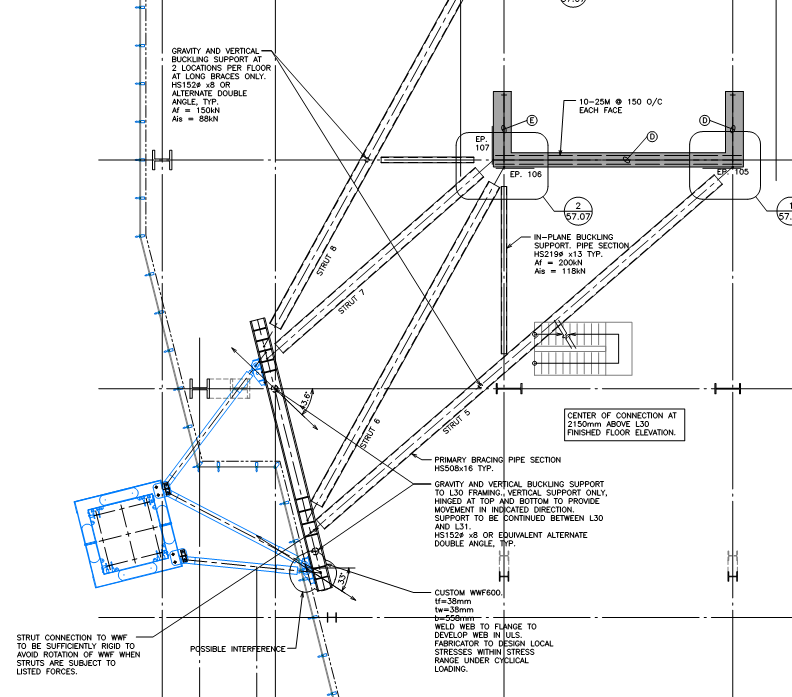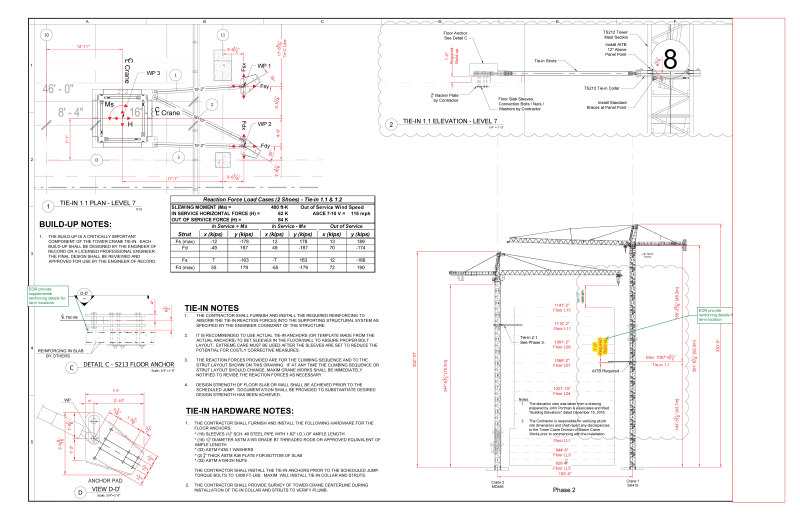RobertHale
Structural
- Jan 4, 2007
- 163
I have received the submittal for the tower cranes of a 22 story flat-slab building. As expected, the manufacturer has identified a couple of locations where the crane will need to be tied to the building for lateral support. In addition to placing the lateral forces in my slab, the manufacturer is also specifying a 1-foot vertical standoff for the connection plates (for a total eccentricity of 1'- 6 1/2". This is outside my wheelhouse, and I want to make sure I am checking all the failure modes and that my methodology is reasonable.
I am going to/have checked the following failure modes: concrete bearing failure of the through-bolt sleeves, concrete breakout of the connection, two-way "punching" shear at the anchorages. I am checking the bolts but not the connecting plate assembly (I am going to put a CYA note on the submittal about it.) I think the checks of the bearing failure and two-way shear are straight forward out of ACI. The concrete breakout has me scratching my head. The one person in my office that has checked this condition for this type of structural system used the Hilti Profis software and ACI App. D to derive a breakout value, but App D specifically precludes conditions with through bolts. The only step I have from there is to apply the cracking strength of the concrete (either 7.5 root f'c or 5 root f'c) to an assumed breakout surface. I have used this method with a 35-degree angle similar to the App. D assumptions. It worries me that this capacity is so much higher than the capacity predicted by App D.
Finally, The height offset is proving difficult to resolve. Initially, I thought that the through bolts and the sleeves would cantilever and the offset would be little more than a shim, but the sleeves fail miserably as cantilevers. For a concrete solution, the interface needs to be reinforced to transfer the 340kip of ultimate shear acting concurrently with 520 kip-ft of moment. The required reinforcing just to satisfy shear friction makes a chunk of concrete extremely impractical to serve this purpose. The only thing I can think of is to provide a steel plate "chair" fabrication to transfer the shear first to the "chair" then from the "chair" into the slab using the bolts. I have checked the specified bolts for the combined tension and shear force using AISC, and it works, but I am not even sure if that is the appropriate code to use for the design of elements like this.
My questions for everybody:
[ol 1]
[li]Is there another check I am completely missing?[/li]
[li]Is the approach to breakout reasonable, and what angle and tensile capacity would you use?[/li]
[li]Any other methods to achieving the offset?[/li]
[/ol]
I would appreciate your thoughts on this and any nuggets of wisdom you may have discovered checking these types of items in your work. Thanks in advance for the help with this.
Robert Hale, PE
I am going to/have checked the following failure modes: concrete bearing failure of the through-bolt sleeves, concrete breakout of the connection, two-way "punching" shear at the anchorages. I am checking the bolts but not the connecting plate assembly (I am going to put a CYA note on the submittal about it.) I think the checks of the bearing failure and two-way shear are straight forward out of ACI. The concrete breakout has me scratching my head. The one person in my office that has checked this condition for this type of structural system used the Hilti Profis software and ACI App. D to derive a breakout value, but App D specifically precludes conditions with through bolts. The only step I have from there is to apply the cracking strength of the concrete (either 7.5 root f'c or 5 root f'c) to an assumed breakout surface. I have used this method with a 35-degree angle similar to the App. D assumptions. It worries me that this capacity is so much higher than the capacity predicted by App D.
Finally, The height offset is proving difficult to resolve. Initially, I thought that the through bolts and the sleeves would cantilever and the offset would be little more than a shim, but the sleeves fail miserably as cantilevers. For a concrete solution, the interface needs to be reinforced to transfer the 340kip of ultimate shear acting concurrently with 520 kip-ft of moment. The required reinforcing just to satisfy shear friction makes a chunk of concrete extremely impractical to serve this purpose. The only thing I can think of is to provide a steel plate "chair" fabrication to transfer the shear first to the "chair" then from the "chair" into the slab using the bolts. I have checked the specified bolts for the combined tension and shear force using AISC, and it works, but I am not even sure if that is the appropriate code to use for the design of elements like this.
My questions for everybody:
[ol 1]
[li]Is there another check I am completely missing?[/li]
[li]Is the approach to breakout reasonable, and what angle and tensile capacity would you use?[/li]
[li]Any other methods to achieving the offset?[/li]
[/ol]
I would appreciate your thoughts on this and any nuggets of wisdom you may have discovered checking these types of items in your work. Thanks in advance for the help with this.
Robert Hale, PE



